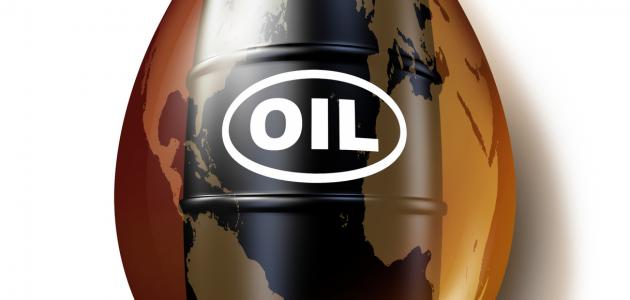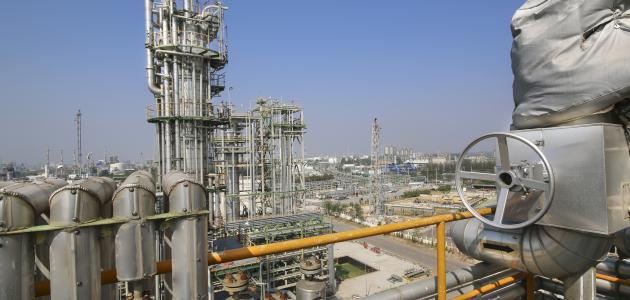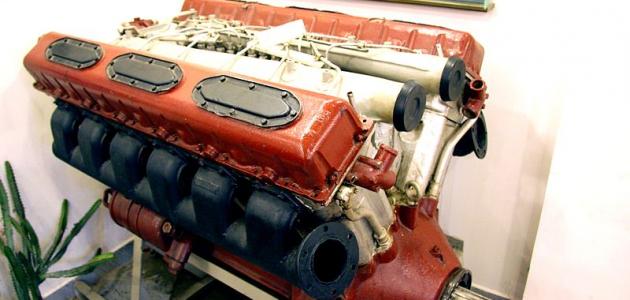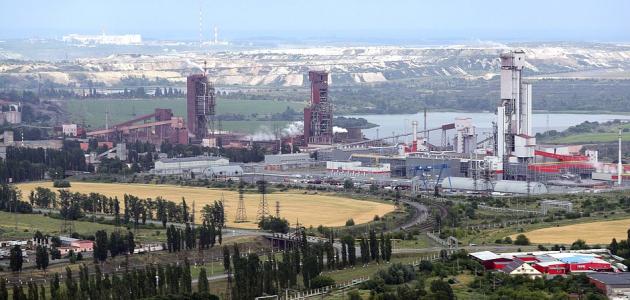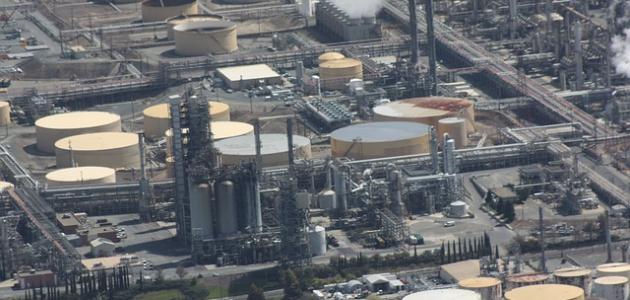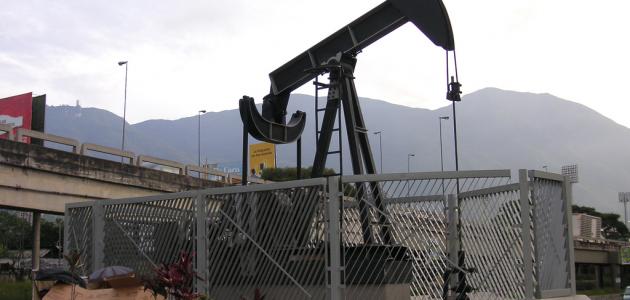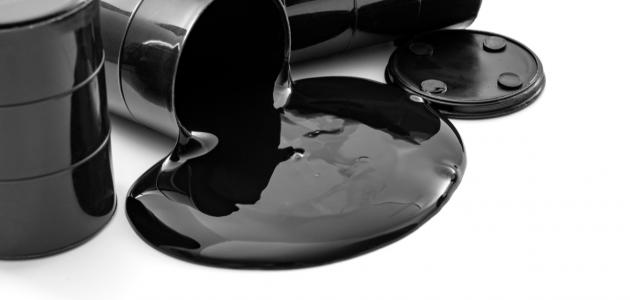Oil
Oil or petroleum consists of a mixture of hydrocarbons formed in the ground, and although oil exists in both gaseous and solid states, this term is usually applied to the liquid form of it, which is also called crude oil. Oil is formed due to the exposure of organic fossils to certain environmental conditions millions of years, and crude oil contains energy stored in the chemical bonds that link hydrogen and carbon atoms, which makes it an ideal source of fuel and energy, and a raw material used in the manufacture of many products. More than 30% of crude oil is extracted in the Middle East; The Kingdom of Saudi Arabia produces (13%) of it, followed by Russia and the United States of America with approximately (12%) each.
Oil derivatives
Oil consists of a mixture of hydrocarbon compounds and liquid organic compounds, and to separate these compounds from each other, crude oil is refined. One of the most common methods of refining oil is the method of fractional distillation, which separates oil derivatives based on their different boiling points.[XNUMX] Among the most important oil derivatives: gasoline, kerosene, lubricating oils, paraffin wax, diesel, asphalt, petrochemicals, liquefied petroleum gas, and fuel oil.
gasoline
Gasoline: a transparent liquid used as fuel for cars; Because of the high energy resulting from its combustion, and thanks to its ability to quickly mix with oxygen in the carburetor, it is also used as fuel for airplanes, compressors, and electric generators. In the beginning, the gasoline was separated from the crude oil by the distillation method, then this method was replaced and the thermal cracking method was used, which depends on heat and high pressure. Later, the catalytic cracking method was used, which depends on chemical reactions. To stimulate the production of a greater amount of gasoline. Gasoline consists of a mixture of hydrocarbons containing (4-12) carbon atoms per molecule, and when mixed, they produce gasoline with different properties. One of the most important characteristics of gasoline is the octane number. It is a measure of the ability of gasoline to resist premature combustion, which increases its efficiency.
Read also:stages of petroleum formationKerosene
Kerosene is a transparent or pale yellow liquid with a bluish tint. It is the main product of the refining process in terms of production volume. It can be obtained by fractional distillation of oil at a temperature of (60-250) degrees Celsius. Kerosene appeared at the beginning of the nineteenth century, and was used in lighting lamps before the discovery of electricity, and was known in the Arab countries as kerosene oil. Kerosene is an essential component of jet engine fuel. Thanks to the characteristics it has; Such as: ignition quality, stable combustion inside the engine, low volatility, viscosity, and appropriate density. Among the types of kerosene:
- Aircraft kerosene: Depending on the degree of its freezing, it is divided into several types, including:
- Jet kerosene (JET A): freezes at a temperature of (-40) degrees Celsius.
- Jet kerosene (JET A-1): freezes at a temperature of (-47) degrees Celsius.
- Jet kerosene (JET B): freezes at a temperature of (-58) degrees Celsius.
- Jet Kerosene (JP-4) freezes at a temperature of (-60) degrees Celsius.
- Jet Kerosene (JP-5): Freezes at a temperature of (-70) degrees Celsius.
- Jet Kerosene (JP-8).
- Jet Kerosene (JP-8-100).
- lighting kerosene: It is kerosene oil lamp fuel.
- Kerosene heating and heating: It is the fuel for household kerosene stoves, agricultural heaters, and small factories.
- Kerosene for engines and machines: It is the fuel for the engines of agricultural equipment, tractors, and some water machinery.
Lubricant
Lubricating oils are used to reduce friction between the surfaces of objects connected to each other, and they are also used as engine oil, as they prevent corrosion and rust, and enhance the transfer of heat and energy. Lubricating oils are characterized by their appropriate viscosity, thermal and hydraulic stability, and their low freezing point. Lubricant oils separate from oil at a boiling point ranging between (300-370) degrees Celsius.
Read also:Oil well drillingParaffin wax
There is paraffin wax (in English: Paraffin Wax) in the form of solid wax at normal temperature, and it is extracted from crude oil as an unwanted by-product, but it has a value in itself, and it can be marketed for multiple uses, including:
- candle making
- Wax pen industry.
- Making cosmetics, such as: Vaseline.
- Preserving, packaging, and serving foods.
- Manufacture of rubber products, paints, regular or stone printing ink, and electric printer wax.
diesel
Diesel, or diesel (in English: Diesel) is one of the oil derivatives that can be obtained using fractional distillation, and it is separated from the oil at a boiling point ranging between (250-350) degrees Celsius. Diesel is used to power gas turbines and external combustion engines. It is also used as fuel in some types of cars, buses, trucks, and locomotives. Diesel quality is measured by the cetane number; It is an indicator of the burning speed of diesel fuel.
asphalt
Asphalt or bitumen (in English: Asphalt) is a black oil derivative with a high viscosity. Asphalt is extracted by the process of crude oil distillation at high temperatures of up to (525) degrees Celsius, and is used for paving streets and painting rooftops. to prevent water leakage.
Petrochemicals
Petrochemicals are chemical products that can be extracted from crude oil and natural gas, and their boiling point ranges from (30-200) degrees Celsius, and they are classified into two groups: olefins, and aromatic compounds (in English: aromatics). Petrochemical materials are used to manufacture many materials, the most important of which are: fertilizers, shoes, wax, food additives, plastic bottles, detergents, and others.
Read also:Where is the largest onshore oil field in the world located?Liquefied petroleum gas
Liquefied petroleum gas is a mixture of hydrocarbon compounds, and its forms are propane and butane,[XNUMX] Here are their most important characteristics:
- Propane (in English: Propane): It is a colorless gas extracted from crude oil or natural gas, and its chemical formula is (C3H8). Propane can be easily liquefied under high pressure, so it is found in its liquid form in cylinders and tanks, and is used alone or mixed with liquid butane as fuel for domestic and industrial uses, and for internal combustion engines.
- Butane (in English: Butane): It is a gaseous hydrocarbon, which is colorless and odorless, and its chemical formula is (C4H10). Butane is added to gasoline car fuel; to increase its volatility.
fuel oil
Fuel oil is the heaviest oil derivative, and it is extracted from it by fractional distillation at a temperature ranging between (370-600) degrees Celsius, and it is used for heating homes, as fuel for trucks and ships, and some types of cars, and for running backup electricity generators in offices, in addition to to power plants
